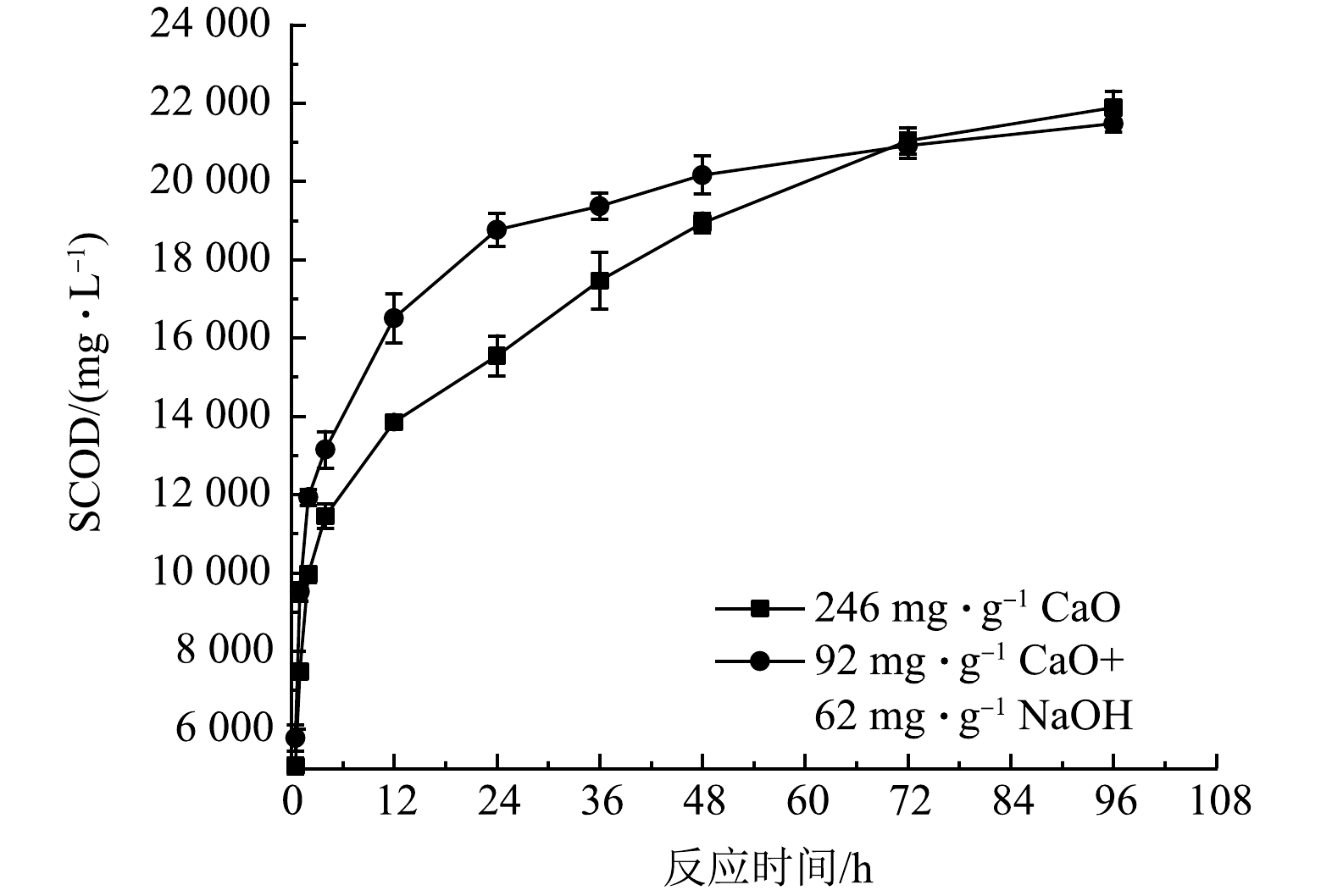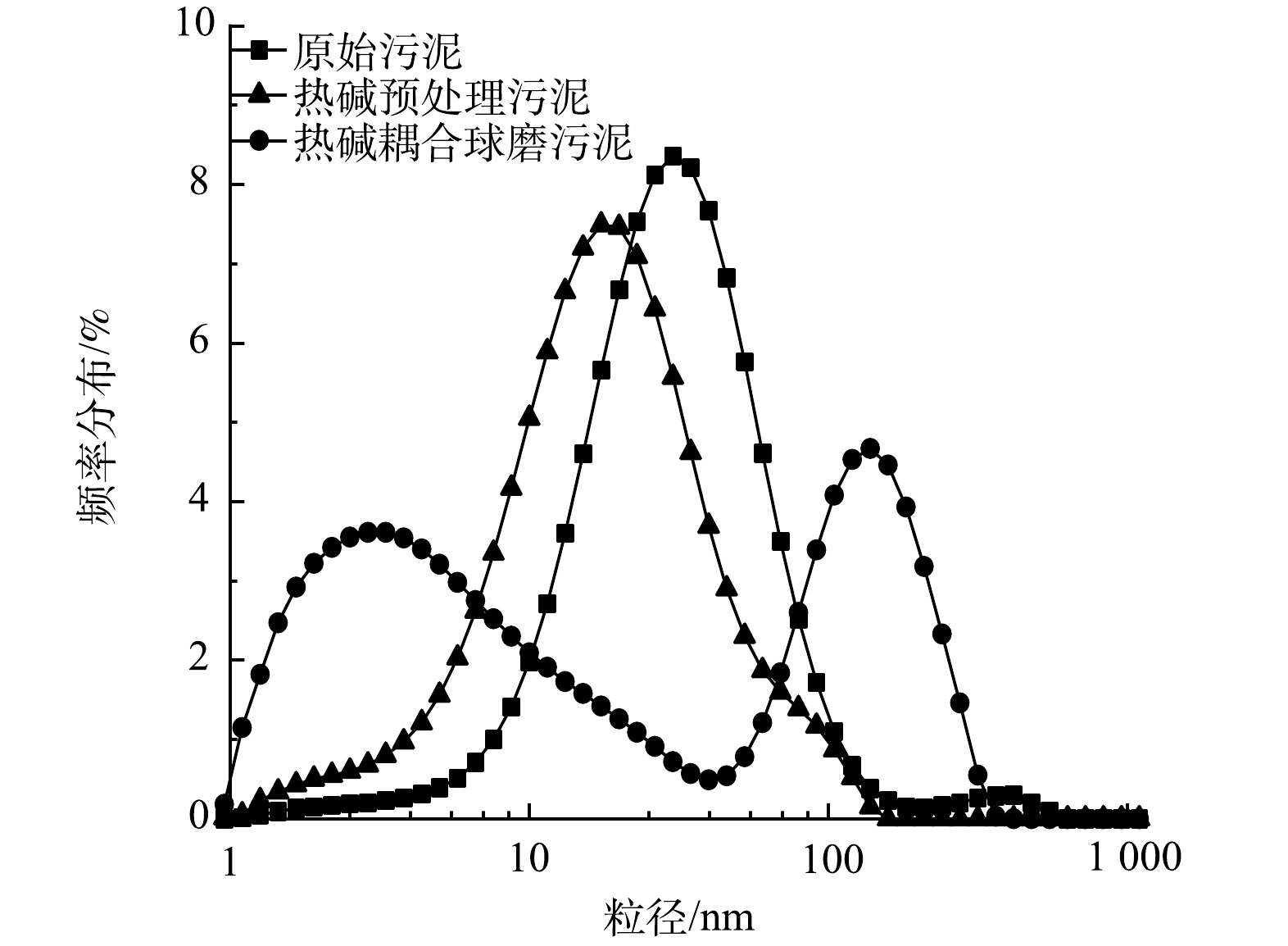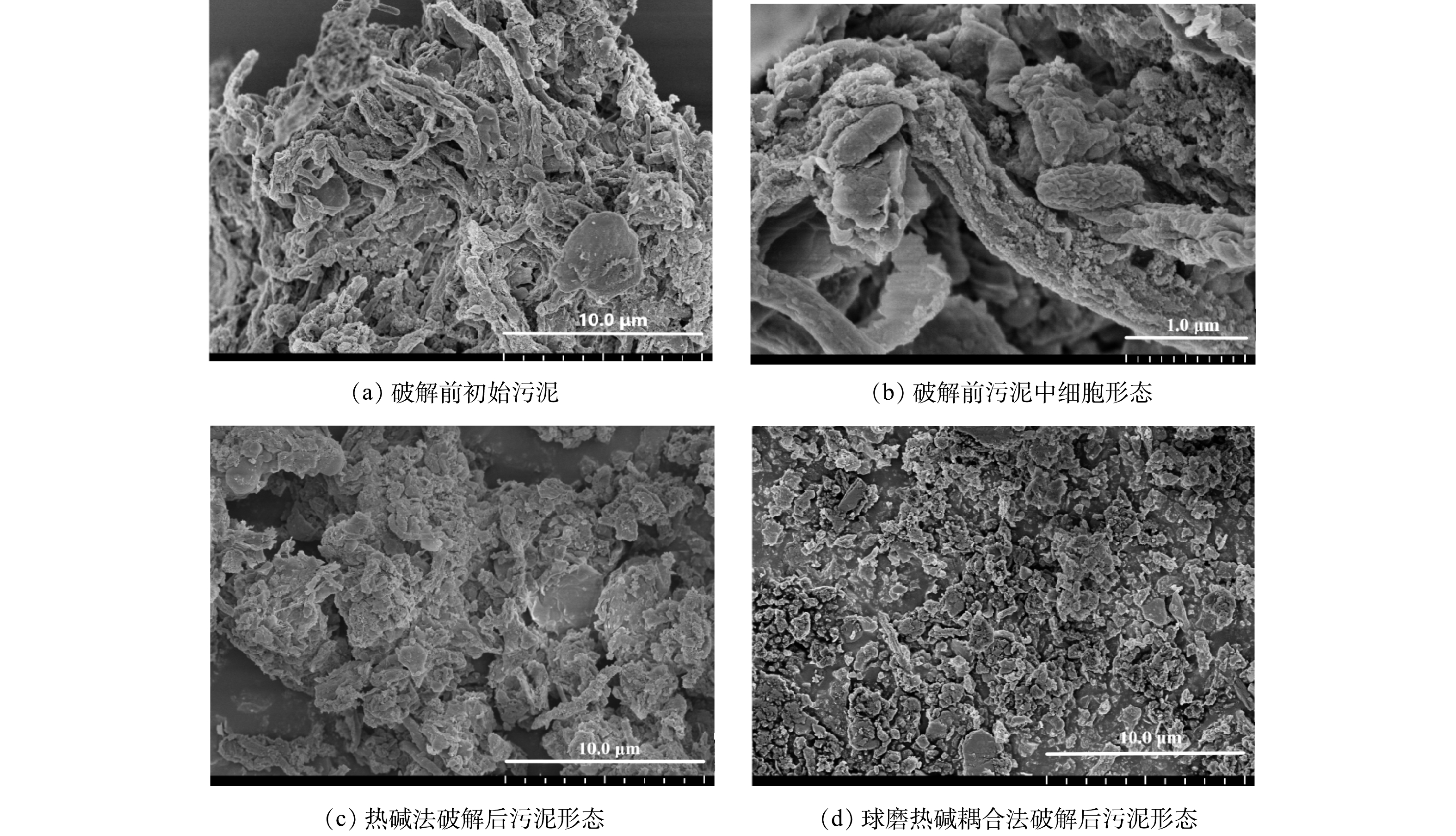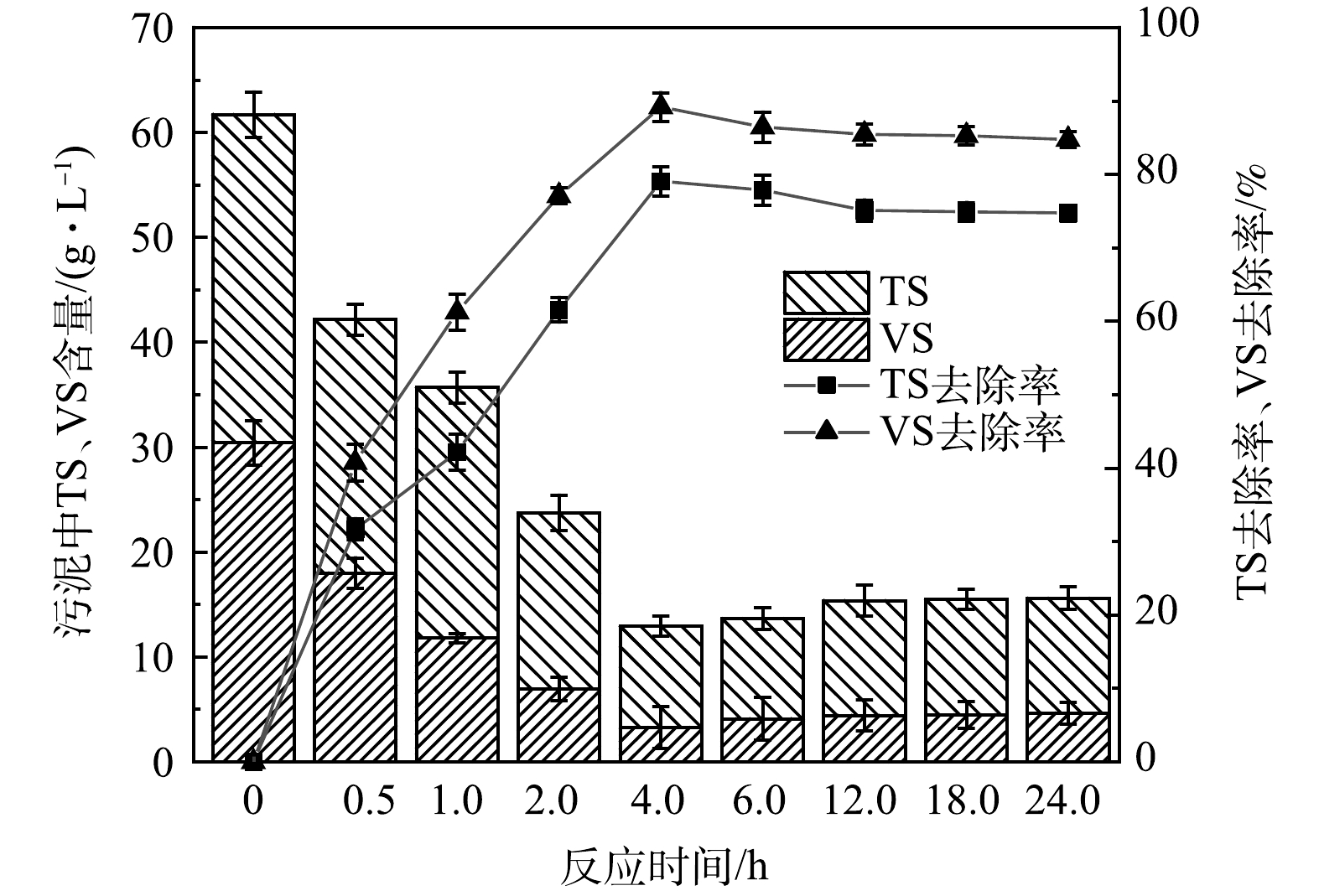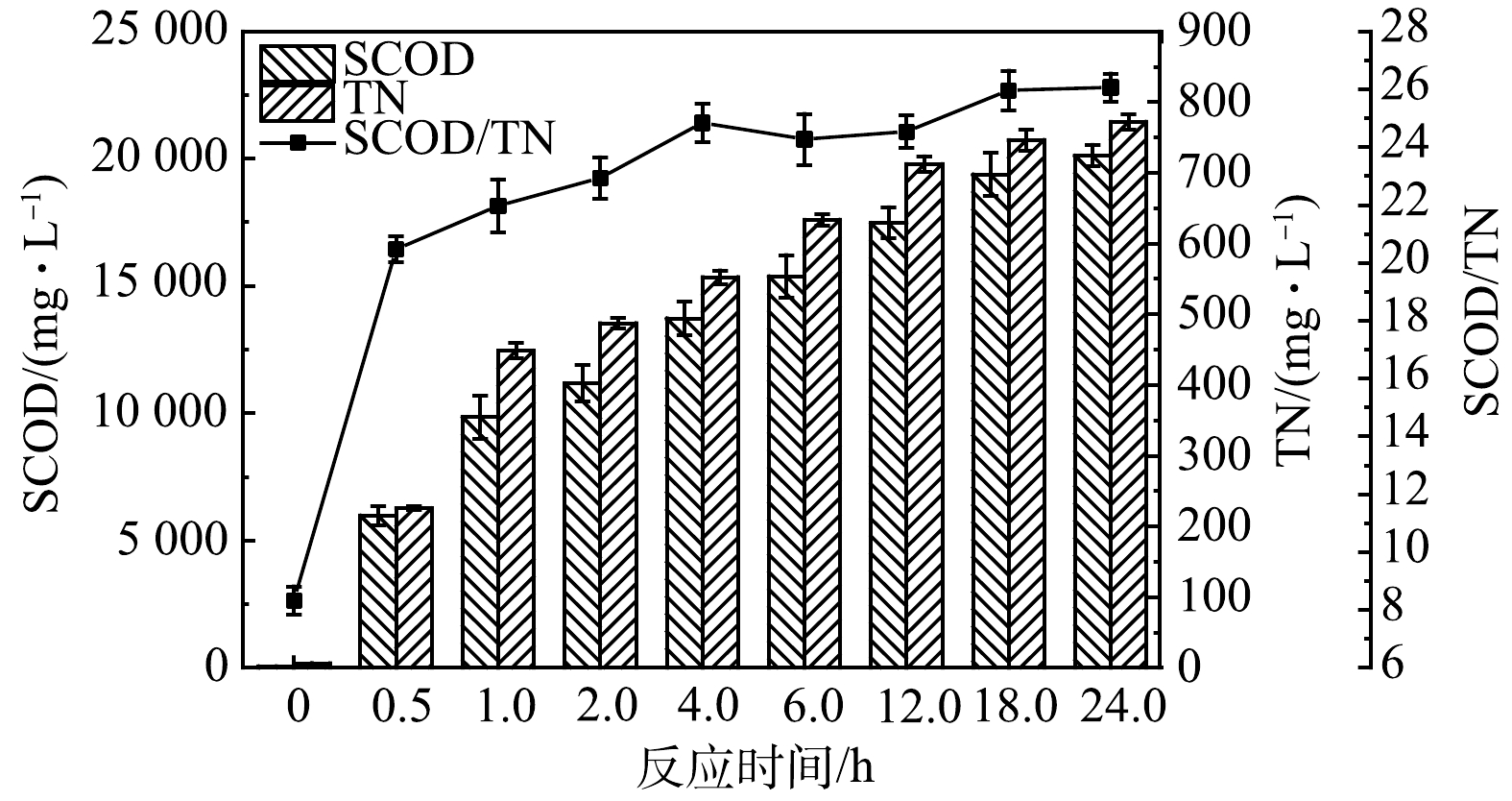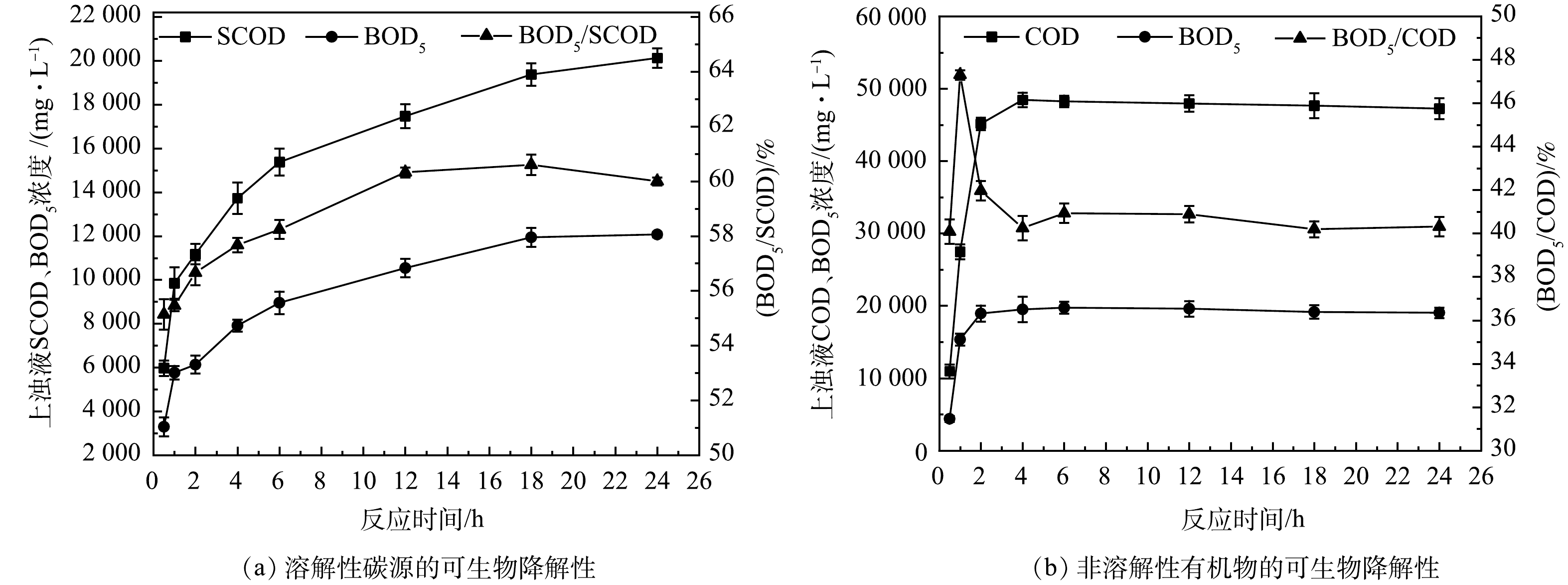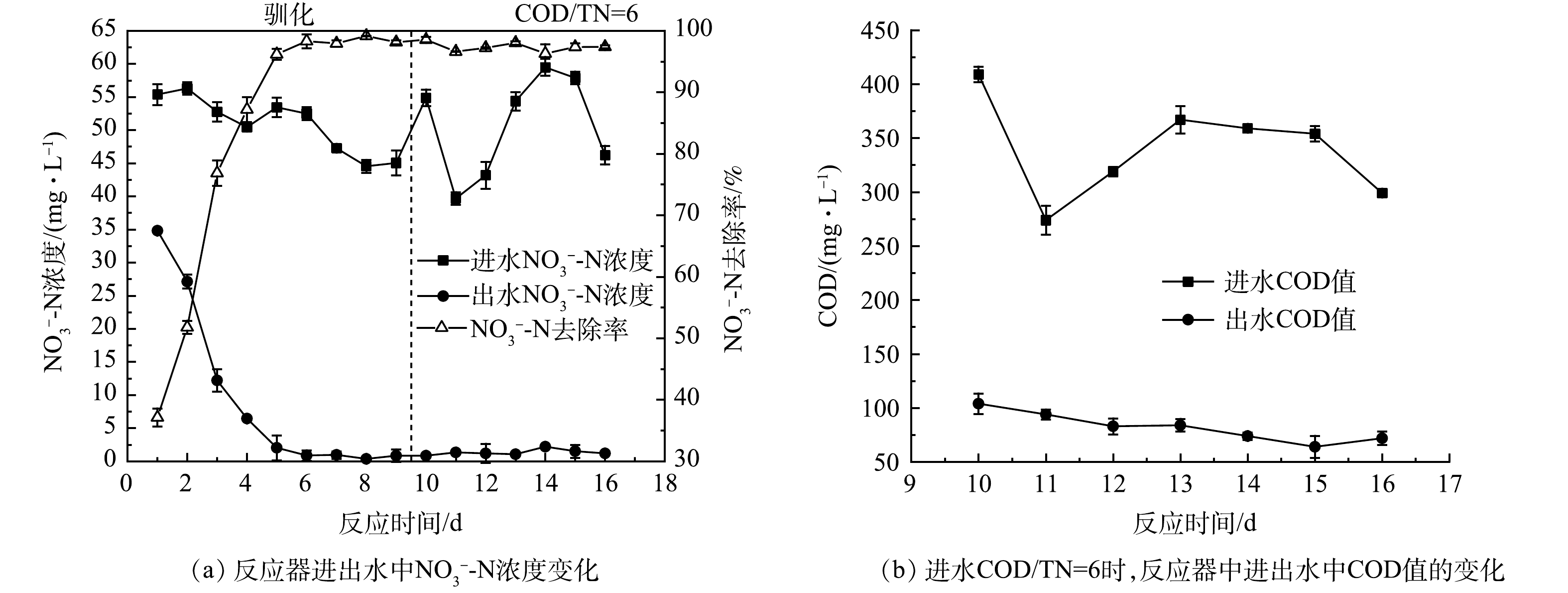-
随着城市化的快速发展,污泥作为废水生物处理工艺中不可避免的副产物[1-2],污泥产量也急速增加[3];另一方面,生物脱氮过程中存在碳源不足的问题,需要在脱氮工艺中外加碳源(甲醇和醋酸等)[4],这种做法可加剧废弃污泥的产率,不经济且不可持续。因此,寻求高效稳定的污泥预处理技术,将污泥胞内优质可生物降解有机物质充分释放[5],以胞内碳源代替外加碳源,实现污泥减量化及资源化利用,具有极其重要的意义。
近年来,国内外学者利用不同污泥预处理方法进行各种尝试和优化[6-11],其中热碱联合处理是最常用方法之一,不仅可提高污泥破解率,还可显著提高破解有机质的生物降解性[12]。代勤等[13]的研究表明,在同等条件下污泥热碱处理后的溶解性化学需氧量(SCOD)是热处理的2.18倍,而且经热碱处理污泥中的溶解性有机物相对分子质量显著减小,明显提高破解液中碳源的生物可利用性。徐慧敏等[14]尝试超声联合热碱技术破解污泥的研究中发现在最佳反应条件(温度 73.06 ℃,加碱量 0.085 g(以1 g湿污泥计),超声能量为9 551 kJ·kg−1)下,污泥破解率可达到60.411%,相较于单一碱处理、超声处理污泥破解效果明显改善,而且使得甲烷产量提高了94%。王开乐等[15]探究了将污泥碱解液用作补充碳源的可行性,发现碱解液代替外加碳源时,NO3−-N去除率达到86%以上。但在现阶段,虽然热碱法回收碳源率有所提升,但回收碳源多为溶解性有机质,污泥中其他大部分大分子非溶解性有机质(如微生物细胞膜、细胞组分和胞外聚合物(EPS)碎片等),仍然得不到充分利用。因此,尝试在热碱破解污泥将溶解性有机质充分释放的基础上,耦合机械破解将污泥中剩余非溶解性有机质碎片全部破解成超细有机颗粒悬浮于上浊液中,实现污泥碳源的高效回收和深度减量化。
基于此,本文主要利用价格低廉的CaO配合少量NaOH(pH约12±0.25),通过球磨热碱耦合法破解污泥,研究了污泥深度减量化、破解液碳源的可生化性以及代替外加碳源的反硝化脱氮效果,以期为污泥的减量化及资源化利用提供参考。
-
污泥取自合肥市某污水处理厂(卡鲁塞尔氧化沟工艺)回流污泥,原始污泥含水率在98.8 %~99.5 %,先经200目筛网滤掉大颗粒杂质,然后经3 000目筛网滤水后使污泥浓缩到含水率约为(93.8±0.35) %作为实验污泥,放置于4 ℃冰柜中保存,在3 d内使用。浓缩污泥理化特性:含水率为(93.80±0.35) %;pH=6.71±0.14;总固体(TS)为(62.15±1.50) g·L−1;挥发性固体(VS)为(32.51±0.83) g·L−1;总化学需氧量(TCOD)为(51 350.00±2 250.00) mg·L−1;溶解性化学需氧量(SCOD)为(53.41±10.50) mg·L−1;TN浓度为(6.41±0.45) mg·L−1。
-
球磨耦合热碱破解污泥处理工艺流程:浓缩→破解→稀释→沉淀→分离上浊液。后续取上浊液进行检测分析,选取最佳处理条件下的上浊液进行反硝化实验,验证该污泥处理工艺碳源的实际反硝化性能。
-
取过筛浓缩污泥300 mL加入500 mL烧杯中,分别控制CaO投加量、反应温度,放置在水浴恒温磁力搅拌器中,以300 r·min−1转速下搅拌1 min,在不同反应时间,提取预处理污泥在5 000 r·min−1转速下离心10 min,取出上清液并经过0.45 μm醋酸纤维微滤膜过滤后检测分析相关水质指标,确定药剂投加量以及最佳反应温度。之后选用复合碱和CaO在相同反应条件下做对比实验。
取过筛浓缩污泥300 mL和1~1.5 mm锆珠600 g加入1 000 mL塑料瓶中,放置于SHA-B水浴恒温振荡器中在以上最佳反应条件下,以300 r·min−1转速下振荡,在不同反应时间,提取预处理污泥放置于烧杯中加水稀释10倍,自由沉降1 h后取出上浊液进行相关水质指标检测,分析其碳源的可生化性以及作为反硝化碳源进行反硝化实验,沉淀的污泥固相残渣经过烘干、灼烧后称重得到TS和VS数据进行污泥减量化分析。(溶解性物质检测均经过0.45 μm醋酸纤维微滤膜过滤后检测)
其中TS去除率作为污泥减量化程度的衡量标准,VS去除率作为污泥中挥发性固体有机物质去除程度的衡量标准,TS和VS去除率分别根据式(1)和式(2)进行计算。
式中:R为污泥TS去除率,%;T0为初始污泥的总悬浮固体含量,g·L−1;T为污泥预处理后的总悬浮固体含量,g·L−1;Q为污泥VS去除率,%;V0为初始污泥的总挥发性悬浮固体含量,g·L−1;V为污泥预处理后的总挥发性悬浮固体含量,g·L−1。
-
实验于6 L SBR中进行,反应器为下进上出式,驯化阶段以葡萄糖为碳源,驯化结束后实验阶段,以上述最佳反应条件下,以上浊液作为碳源,以KNO3为氮源,其他营养物质添加如表1所示。原始污泥取自合肥市某污水处理厂(卡鲁塞尔氧化沟工艺)回流污泥,反应器中污泥浓度为5 000~6 000 mg·L−1,参数设置为:HRT=6 h (进水0.5 h、反应4 h、沉淀1 h、出水0.5 h),COD/TN=6 (±0.5),T=28 ℃,pH=7.0,DO≤0.3 mg·L−1,反应器持续运行,每天定时取样1次,进行水质指标检测。
-
分析方法:水质指标检测分析方法参考《水和废水监测分析方法》(第四版),检测COD以及SCOD均采用重铬酸钾法,TN选用过硫酸钾紫外分光光度法,NO3−-N选用紫外分光光度法(紫外可见分光光度计 TU 1950);BOD5选用稀释接种法;预处理污泥中溶解性有机物分析采用三维荧光发射光谱仪分析(F-7000,日本日立);污泥粒径采用激光粒度仪分析(MS2000, 英国马尔文);污泥微观形貌采用生物扫描电子显微镜(SU8010,日本日立);污泥中的TS采用烘干重量法测定,VS采用管式炉(YL24-M338704)灼烧减量法测定。
检测试剂:NaOH、CaO、浓硫酸、硫酸银、硫酸汞、重铬酸钾、过硫酸钾、浓盐酸等试剂均为分析纯;实验所用水均为去离子水(实验室纯水系统Smart-Q15,上海和泰仪器有限公司)。
-
1)控制不同反应条件下CaO对污泥破解液中SCOD的影响。以破解液中SCOD的变化作为指标评价不同投加量的CaO对污泥的破解效果,结果如图1所示。由图1(a)可见,常温条件下,随着CaO投加量的增加, 破解液中SCOD也随之增加。反应初期,由于CaO溶于水发生反应[CaO+H2O→Ca(OH)2],反应的过程中放出热量[16-17],使得OH−迅速与污泥絮体以及细胞壁(膜)中蛋白质和脂质发生水解反应[18],促使细胞质流出进而导致液相中SCOD迅速增加;反应24 h后,SCOD释放速率开始减慢,经4 d破解后,在CaO投加量为92、123、185、246、308 mg·g−1(以污泥VS干质量计)时,破解液中SCOD值分别可以达到7.311×103、8.114×103、9.144×103、9.622×103、9.721×103 mg·L−1。当CaO投加量超过246 mg·g−1时,增加药剂投加量,污泥中释放的SCOD值基本不再增加。
为进一步提高污泥的破解效率,将CaO投加量控制在246 mg·g−1,水浴温度对SCOD释放情况的影响结果如图1(b)所示。当温度大于60 ℃时,液相中SCOD显著增加,说明60 ℃是细胞破解的阈值。当水浴温度超过60 ℃时污泥细胞开始破裂,使得胞内有机质释放到液相中导致SCOD迅速增加,这与WU等[19]的结论相同。此外,代勤等[13]发现,污泥微生物细胞在热碱双重作用下更易破解,在热碱条件下微生物细胞发生膨胀,削弱细胞壁并破坏EPS,使得OH−更易水解EPS及细胞膜[12],打破细胞内外压力平衡,导致细胞破裂和胞内物质的释放。故热碱联用可以显著增加污泥胞溶效果,此外,由图1(b)可发现,当温度高于80 ℃时对SCOD释放提升效果并不明显,100 ℃时相比于80 ℃液相中SCOD由2.074×104 mg·L−1提升至2.189×104 mg·L−1,仅增加了5.5 %。因此,选择80 ℃作为反应条件更具经济性。由图1(c)可知,在80 ℃下污泥TS去除率随着药剂投加量的增加而上升,但当CaO的投加量超过246 mg·g−1时,反应后污泥中TS去除率反而开始下降。推测可能是由于部分Ca(OH)2沉淀导致污泥TS增加[20-21]。根据上述结果,最佳水浴温度为80 ℃,最佳CaO投加量为246 mg·g−1。
2)不同碱性药剂对污泥破解液中SCOD释放效率对比分析。由图1可知,在80 ℃以及246 mg·g −1 CaO的最佳反应条件下,虽然液相中SCOD可达到2.074×104 mg·L−1,但由于Ca(OH)2溶解性较低,OH−离子不能迅速完全释放,导致其反应时间较长,预处理成本过大不符合工程实况。因此,在控制所投入药剂成本下,在与投加246 mg·g−1的CaO相同pH(pH~12)下,选用复合碱(92 mg·g−1 CaO+62 mg·g−1 NaOH),探究反应速率及SCOD的释放情况,结果如图2所示。
由图2可知,在相同反应条件下,复合碱在24 h前显著提高了液相中SCOD值,此时复合碱比使用单独CaO处理液相中SCOD增量达到峰值3.218×103 mg·L−1增加了20.7%。说明复合碱的投加可有效提高污泥破解速率,大大缩短反应时间;反应72 h后投加复合碱的实验组中SCOD变化基本趋于平缓,而单独投加CaO的破解液中SCOD还在持续缓慢释放,说明在长时间的反应下CaO破解污泥可能优于复合碱,但反应时间太长导致处理成本增加。根据工程实际情况选择复合碱作为处理药剂最具有经济性。因此,综合图1和图2的结果,在水浴温度80 ℃下投加复合碱反应24 h为最佳反应条件。
3)球磨对热碱破解污泥的提升效果分析。采用以上复合热碱法破解污泥,虽然已显著提高碳源溶出率,但污泥残渣中大量非溶解性大颗粒有机质仍然得不到充分利用,而且此前本课题组发现,污泥经反应条件(泥珠比1:2、锆珠1~1.5mm、转速300 r·min−1)处理后可产生大量的1 μm以下微小颗粒[22],为进一步提高污泥内源性碳源的充分利用,尝试采用球磨热碱耦合法破解污泥,破解过程中液相中的SCOD和COD释放情况如图3所示。
如图3(a)所示,反应24 h后,单独球磨、热碱以及球磨热碱耦合法上浊液中SCOD值分别可以达到1.154×104、1.876×104、2.013×104 mg·L−1。可以看出球磨热碱耦合法相比热碱法,对上浊液中SCOD溶出有促进作用,但提升效果不明显,说明球磨在将非溶解生物质分解成溶解态有机物方面效果不理想[23];但上浊液中COD值相比于对照组(球磨处理、热碱处理)有显著提升。如图3(b)所示,球磨热碱耦合法在反应4 h后上浊液中COD值已经基本到达释放极限4.945×104 mg·L−1,相比于初始污泥TCOD值释放率达到95.1 %。同时球磨热碱耦合法破解污泥在反应初期破解液中SCOD值和COD值均高于单一球磨法或热碱法,说明机械和热碱技术联用在破解污泥方面可相互促进。分析其破解机理,随着机械破碎的加入,锆珠之间的剪切力首先削弱并破解污泥絮体结构[24],使得液相中OH−更容易接触并破坏细胞结构,促进胞内有机质的溶出;同时在热碱作用下,污泥EPS发生水解,碱与细胞壁(膜)中的脂质发生皂化反应[12],减小了机械破解的阻力,加快了球磨效率。随着球磨时间的延长到达4 h后破解液中COD值基本到达极限,说明此时污泥絮体及细胞结构已充分破碎,将大块细胞碎片破碎成超细有机颗粒悬浮于液相中,同时在图4、5中污泥预处理后的微观形态也证明了此实验结果。归纳以上分析可知,最优破解条件为:在水浴温度80 ℃下,投加复合碱(92 mg·g−1 CaO+62 mg·g−1 NaOH),球磨4 h,反应24 h。
-
不同预处理方法对污泥粒径的影响情况如图4所示。可见,污泥经热碱预处理后,频率分布的粒径峰值左移,中值粒径由28.1 μm减小为19.1 μm,粒径明显减小。污泥经球磨热碱耦合法处理后,由于粒径分峰效应对2.5 μm左右超细颗粒有屏蔽作用,所以导致中粒径仅降至12.6 μm后没有进一步降低。但由图4可知,在1~10 μm内有大量超细颗粒,结合图3(b)中此时上浊液中COD值基本释放到极限状态,说明球磨热碱耦合法可有效将污泥絮体及细胞破碎形成超细有机颗粒,同时粒径的减小会增加有机颗粒的比表面积,有利于微生物与其接触,提高非溶解性有机物质被利用的概率[12]。同时在135.0 μm左右出现明显的分峰现象,分析原因,由于污泥细胞的破碎,胞内含有的聚合物(例如蛋白质、核酸、多聚糖等)释放到液相中,导致细胞碎片发生再絮凝现象[25-26],从而产生部分絮凝团,导致粒径增大。
污泥经不同处理后微观形态变化如图5所示。如图5(a)~(b)所示,初始污泥絮体结构完整且呈现紧密的块状,而且可以明显看出杆状细菌细胞紧密附着在污泥絮体中。如图5(c)所示,经热碱处理后,污泥絮体结构被破坏,组织结构变得松散,细菌细胞受到断裂和破裂但没有完全破碎,污泥形态发生变化。经球磨耦合热碱处理后,如图5(d)所示,污泥絮体结构明显分解成微小碎片,此时原本较大的絮体结构和网状结构已完全解体,而且污泥细胞结构进一步破碎以细胞碎片呈现,使胞内有机物质充分释放。说明球磨的加入提高了污泥的破解效率,而且产生微米级碎片,进一步提高污泥碳源的可生物降解性。
-
如图6所示,通过污泥反应前后TS和VS的变化分析污泥减量化效率。可见,在最佳反应条件下,污泥TS由初始值61.7 g·L−1降至15.6 g·L−1,去除率达到74.7%;VS由30.4 g·L−1下降到4.6 g·L−1,去除率达到84.7%。说明在球磨与热碱协同作用下,污泥减量化效率显著提高。在4 h球磨结束后,预处理污泥中TS和VS含量稍有回升,结合图4中污泥粒径的分峰结果,推测可能由于随着污泥细胞破碎,部分絮体碎片发生再絮凝现象[26],使得部分絮凝团沉降导致污泥中TS和VS有少量增加。
-
1)污泥破解液中碳氮比值的变化。在对废水进行生物处理过程中进水碳源、总氮及总磷浓度是影响生物脱氮除磷的关键因素,然而,现阶段污泥资源化利用的研究主要集中在碳源的释放,而忽略了污泥破解液中SCOD/TN以及SCOD/TP对污泥内碳源回收的影响。WANG等[27]提出活性污泥理论化学式可表示为C118H170O51N17P,虽然C、N、P的释放对于污泥胞内碳源的有效利用均有影响,但由于污泥中TP理论释放量较少[28-30],对于碳源的有效利用率影响不大,因此,后续主要以TN的释放展开研究。LI等[28]的研究表明,进水中SCOD/TN对生物去除TN的理论需求为6.0。如图7所示,在最佳反应条件下的破解液中SCOD/TN随着反应时间延长而增加,尤其反应初期随着胞内有机物质的释放,液相中SCOD/TN迅速增加,最终液相中SCOD/TN从初始8.33上升至26.06,远高于生物去除TN的理论需求。这说明该反应条件下的破解液中释放的TN 不足以对反硝化产生负面的影响。
2)污泥破解液中荧光性有机物质成分。采用三维荧光光谱分析球磨热碱耦合法处理后污泥上清液中荧光性有机物质组成的影响,结果如图8所示。由图8(a)可以看出,该三维荧光图中存在3个峰:色氨酸类物质(Ex/Em=225 nm/330 nm) (A 峰),微生物代谢副产物类物质(Ex/Em=275 nm/325 nm) (B峰) 和胡敏酸类物质(Ex/Em=325 nm/400 nm) ( C峰),其中胡敏酸类物质( C峰) 荧光强度较其他2 个峰不明显。这说明初始污泥上清液中荧光性有机物质以易生物降解的色氨酸类物质、微生物代谢副产物类物质为主,而胡敏酸类物质较少,这主要和不同污泥性质有关。经球磨耦合热碱预处理后,污泥上清液中荧光性有机物质的三维荧光光谱荧光强度发生明显变化。如图8(b)所示,破解液中易生物降解物质色氨酸类物质(A峰)和微生物代谢副产物类物质(B峰)荧光强度显著增强,且占据主导地位,说明破解液中溶解性碳源拥有较为理想的生物降解性。
3)污泥破解液中碳源的可生物降解性。在好氧条件下,污泥上清液的可生物降解性以BOD5/SCOD[31]为评估指标,当BOD5/SCOD超过0.3时说明生物降解性良好。如图9可知,污泥在最佳反应条件(水浴温度80 ℃,球磨4 h,复合碱154 mg·g−1,反应24 h)下,溶解性碳源的可生物降解性(BOD5/SCOD)可以达到0.602(1.206×104 mg·L−1/2.013×104 mg·L−1),非溶解性碳源的可生物降解性(BOD5/COD)最后可达到0.403(1.905×104 mg·L−1/4.725×104 mg·L−1),说明球磨热碱耦合法破解污泥产生的碳源拥有优异的可生物降解性。
由图9(a)可见,在反应初期,BOD5/SCOD由0.298迅速上升到0.563,说明此时污泥细胞开始大量破解,胞内有机碳源释放到液相导致此时溶解性碳源的可生物降解性迅速上升,反应1 h后 BOD5/SCOD开始缓慢上升,推测此前释放到液相中的有机物质,在温度和碱性条件下发生进一步水解,转化为易生物利用的小分子物质(如挥发性脂肪酸、小分子糖类等)[18],进一步提高了碳源的可生物降解性,而且在图6污泥处理前后三维荧光光谱图中也发现,处理后液相中易生物降解物质(色氨酸类物质和微生物代谢副产物类物质)荧光强度显著增强,也证明破解液中碳源拥有优异的可生物降解性。当反应18 h后,BOD5/SCOD有所下降,可能是部分氨基酸等有机物质发生美拉德反应,产生难生物降解类黑素物质的积累[32],导致BOD5/SCOD略有下降。由图9(b)可知,在反应1 h前,BOD5/COD由0.298迅速上升到0.469到达峰值,反应1 h后BOD5/COD开始迅速下降,说明随着机械破碎的进行,污泥中EPS、细胞壁(膜)等大分子有机物质,开始破碎为微小颗粒悬浮于上浊液中,导致液相中COD迅速上升而BOD5提升有限,使之下降;反应4 h后,BOD5/COD比值虽有轻微波动,但整体已趋于稳定。以上结果说明,污泥经球磨热碱耦合法处理后产生的碳源具有较为理想的可生化性。
-
如图10(a)所示,反硝化反应器连续运行9 d后,反应器中NO3−-N去除率稳定高于97%,表明污泥驯化成功。污泥驯化成功后,以球磨热碱耦合法破解污泥上浊液代替碳源以用于反硝化实验中(10~16 d),控制进水COD/TN=6±0.5,其他营养物质投加量如表1所示。反应器连续运行,NO3−-N去除效果如图10(a)所示。在反硝化碳源被污泥破解液替换后,反应器中NO3−-N去除率依然高于97.0%,同时反应器出水NO3−-N浓度稳定。说明经该方法处理后污泥的上浊液中碳源可被反硝化细菌有效利用,但由于上浊液中部分非溶解有机物质颗粒的生物降解性较低,导致出水COD略高,在第16天时出水COD达到72.13 mg·L−1(图10(b))。
为了进一步了解COD/TN=6时破解液的反硝化特性,将反应器运行稳定后(第16天)反应器中上清液排空后,加入以破解污泥上浊液为碳源的模拟废水(COD/TN=6.0±0.5),检测反应器反应过程中NO3−-N、TN的浓度变化情况,结果如图11所示。可见,反应初期NO3−-N的浓度迅速降低,然后下降速度变缓,然而,与NO3−-N相比,反应前期TN浓度的下降速度较慢,说明反应前期有NO2−-N的积累。这可能由于硝酸盐还原菌对碳源的竞争能力比亚硝酸盐还原菌强[33],当大部分NO3−-N还原后,NO2−-N才开始还原。待反应完成后,初始NO3−-N质量浓度为37.89 mg·L−1,出水NO3−-N降为0.13 mg·L−1,NO3−-N去除率达到99.6%,同时TN质量浓度由45.05 mg·L−1降至9.12 mg·L−1,TN去除率达到79.7%。该研究结果表明,经球磨热碱耦合法破解后污泥上浊液中的碳源拥有优异的反硝化效果,可代替反硝化外加碳源。
-
1)球磨热碱耦合法可有效提升污泥的破解效果。在水浴温度为80 ℃、球磨时间为4 h、投加92 mg·g−1 CaO+62 mg·g−1 NaOH且破解24 h后,SCOD值达到2.013×104 mg·L−1,COD达到4.725×104 mg·L−1。
2)预处理前污泥中TS为61.7 g·L−1,处理后下降至15.6 g·L−1,去除率达到74.7%;处理后的VS由30.4 g·L−1降至4.6 g·L−1,VS去除率达到84.7%,说明有效实现污泥的深度减量化。
3)污泥经预处理后,上浊液中SCOD/TN达到26.06,远高于生物去除TN的理论需求,液相中荧光性有机物质组成以易生物降解的色氨酸类物质和微生物代谢副产物类物质为主,说明其具有较好的可生物降解性能。
4)以破解污泥上浊液中的碳源代替反硝化外加碳源,控制进水COD/TN=6,稳定后NO3−-N去除率基本稳定97.0%以上,说明经过此预处理后污泥上浊液中的碳源可有效作为反硝化碳源使用。
球磨热碱耦合法破解污泥-释放碳源及污泥减量化的效率
Efficiency of sludge cracking-carbon source release and sludge reduction by a ball milling-thermo-alkali coupling method
-
摘要: 研究了球磨热碱耦合法破解污泥释放碳源的效率,进一步探索了直接以破解液代替外加碳源用于反硝化脱氮的可行性,并研究了该方法对污泥减量化的效果。结果表明,在水浴温度80 ℃,复合碱投加量为154 mg·g −1(以污泥VS干重计),反应24 h后,对于浓缩后含水率为93.8%的污泥,破解液中SCOD达到2.013×104 mg·L−1,COD达到4.725×104 mg·L−1。三维荧光光谱显示,污泥破解液中荧光性有机物质以易生物降解的色氨酸类和微生物代谢副产物类占据主导地位。污泥处理前后,TS由61.7 g۰L−1下降至15.6 g۰L−1,其中部分超细颗粒随上浊液回收利用,污泥减量化程度达到74.7%;VS由30.4 g۰L−1下降到4.6 g۰L−1,挥发性有机质的去除率达到84.7%。粒径分析结果表明,原始污泥中值粒径由预处理前28.1 μm降为12.6 μm,粒径显著减小,并产生2.5 μm左右的细颗粒悬浮于破解液。随后以破解污泥沉淀后的上浊液直接作为替代碳源,在模拟的反硝化实验中(外加硝酸钾作为氮源),反应器持续运行稳定后,NO3−-N的去除率均高于97.0%。以上结果表明球磨热碱耦合法是一种非常高效污泥减量化方法,破解液可有效作为反硝化碳源使用,污泥资源化和减量化效果好,是一种非常有前途的污泥处理处置方法。Abstract: In this study, the efficiency of carbon source released from sludge by a ball milling-thermal alkali coupling method was investigated, and the feasibility of directly replacing the external carbon source with the cracking solution for denitrification was further explored, as well as the effect of this method on sludge reduction. The results showed that, for the sludge with concentrated water content of 93.8%, at the water bath temperature of 80 ℃, the compound alkali dosage of 154 mg·g−1(calculated by sludge VS dry weight), SCOD and COD in the cracking solution reached 2.013×104 mg·L−1 and 4.725×104 mg·L−1 after reaction for 24 h, respectively. As indicated by three-dimensional fluorescence spectra, the fluorescent organic substances in the sludge cracking solution were dominated by easily biodegradable tryptophan and microbial metabolic byproducts. Before and after sludge treatment, the TS decreased from 61.7 g·L−1 to 15.6 g·L−1, and some ultra-fine particles were recycled with the upper turbidity solution, and the sludge reduction degree reached 74.7%. VS decreased from 30.4 g·L−1 to 4.6 g·L−1, and the removal rate of volatile organic matter reached 84.7%. As suggested by the particle size analysis results, the median particle size of the original sludge decreased from 28.1 μm ( before pretreatment) to 12.6 μm, and fine particles with a particle size of about 2.5 μm were produced and suspended in the cracking solution. Subsequently, the upper turbidity solution after sludge cracking sedimentation was directly used as the carbon source. In the simulated denitrification experiment (with the potassium nitrate added externally as the nitrogen source). Moreover, the removal rate of NO3−-N was higher than 97.0% after continuous and stable operation of the reactor. As demonstrated by the above experimental results, the ball milling-thermal alkali coupling method is a tremendously efficient sludge reduction method. Aside from that, the cracking solution can be effectively used as the denitrification carbon source owing to the satisfactory effects of sludge reclamation and reduction. Altogether, it is a considerably promising sludge treatment and disposal method.
-

-
表 1 模拟废水营养物质组成
Table 1. Simulated nutrient composition of wastewater
指标名称 投加量/(mg·L−1) 投加药品名称 COD 200~400 葡萄糖或污泥破解液 NO3−-N 50 KNO3 TP 12 KH2PO4 碳酸氢钠 59 NaHCO3 Mg 8 MgSO4·7H2O -
[1] BOUABIDI Z B, El-NAAS M H, ZHANG Z. Immobilization of microbial cells for the biotreatment of wastewater: A review[J]. Environmental Chemistry Letters, 2019, 17(1): 241-257. doi: 10.1007/s10311-018-0795-7 [2] PALMER S, NOONE G, HOYLAND G. A review of physical relationships between form and function in wastewater biotreatment and a new theory relating activated sludge and biofilm systems behaviour[J]. Water and Environment Journal, 2021, 35(1): 148-157. doi: 10.1111/wej.12614 [3] 刘子娟, 王寅义, 徐肖甜, 等. 剩余污泥碱性发酵产酸及脱水性能研究[J]. 中国给水排水, 2022, 38(3): 92-98. doi: 10.19853/j.zgjsps.1000-4602.2022.03.015 [4] WU Y, SONG K, JIANG Y, et al. Effect of thermal hydrolysis sludge supernatant as carbon source for biological denitrification with pilot-scale two-stage anoxic/oxic process and nitrogen balance model establishment[J]. Biochemical Engineering Journal, 2018, 139: 132-138. doi: 10.1016/j.bej.2018.08.013 [5] YANG S, WANG Q, ZHANG T, et al. Biological nitrogen removal using the supernatant of ozonized sludge as extra carbon source[J]. Ozone:science & engineering, 2011, 33(5): 410-416. [6] LEE M J, KIM T H, YOO G Y, et al. Reduction of sewage sludge by ball mill pretreatment and Mn catalytic ozonation[J]. KSCE Journal of Civil Engineering, 2010, 14(5): 693-697. doi: 10.1007/s12205-010-0934-6 [7] 蔡辰, 杨婉, 杨东海, 等. 水热处理高含固污泥的无害化效能和资源属性影响[J]. 环境科学学报, 2020, 40(10): 3719-3725. doi: 10.13671/j.hjkxxb.2020.0382 [8] 赵薇, 陈男, 刘永杰, 等. 以超声波破解剩余污泥为碳源强化污水脱氮[J]. 环境工程, 2019, 37(3): 44-49. [9] 刘艳芳, 王凌霄, 马骏, 等. 剩余污泥臭氧化过程中磷的释放及形态转化[J]. 环境科学学报, 2019, 39(09): 3039-3044. doi: 10.13671/j.hjkxxb.2019.0133 [10] KIM T H, NAM Y K, PARK C, et al. Carbon source recovery from waste activated sludge by alkaline hydrolysis and gamma-ray irradiation for biological denitrification[J]. Bioresource technology, 2009, 100(23): 5694-5699. doi: 10.1016/j.biortech.2009.06.049 [11] ATAY Ş, AKBAL F. Classification and effects of sludge disintegration technologies integrated into sludge handling units: an overview[J]. Clean-Soil, Air, Water, 2016, 44(9): 1198-1213. doi: 10.1002/clen.201400084 [12] 唐心漪, 陈翔宇, 肖本益, 柳荣展. 剩余污泥热碱处理及其对污泥厌氧消化的强化研究进展[J]. 环境工程, 2022, 40(5): 218-226. doi: 10.13205/j.hjgc.202205031 [13] 代勤, 张文哲, 于潘芬, 等. 热、热碱处理对污泥溶胞和溶解性有机物的影响[J]. 环境科学, 2018, 39(5): 2283-2288. [14] 徐慧敏, 秦卫华, 何国富, 等. 超声联合热碱技术促进剩余污泥破解的参数优化[J]. 中国环境科学, 2017, 37(9): 3431-3436. doi: 10.3969/j.issn.1000-6923.2017.09.029 [15] 王开乐, 周集体, 田天, 等. 剩余污泥碱解液用作低C/N合成氨废水反硝化碳源研究[J]. 环境工程, 2021, 39(12): 31-37. [16] 曾庆洋, 伍健东, 周兴求, 等. 石灰投加比对污泥低温干燥特性及冷凝液性质的影响[J]. 环境工程学报, 2017, 11(10): 5603-5608. doi: 10.12030/j.cjee.201611158 [17] 张博, 赵益华, 陶君, 等. CaO对高浓度污泥厌氧消化性能的影响机理及动力学分析[J]. 环境工程, 2021, 39(4): 140-146. doi: 10.13205/j.hjgc.202104022 [18] LIU B, JIN R, LIU G, et al. Effect on sludge disintegration by EDTA-enhanced thermal-alkaline treatment[J]. Water Environment Research, 2020, 92(1): 42-50. doi: 10.1002/wer.1156 [19] WU Y, JIANG Y, SONG K. Carbon source recovery from waste activated sludge by low-temperature thermal hydrolysis process[J]. Journal of Environmental Engineering, 2020, 146(1): 04019098. doi: 10.1061/(ASCE)EE.1943-7870.0001631 [20] 林珊伊, 孙德安, 朱明瑞, 等. 芬顿与氧化钙联合处理填埋库污泥的力学特性[J]. 环境工程学报, 2020, 14(10): 2813-2822. doi: 10.12030/j.cjee.201912027 [21] 王均凤, 李志宝. 二水硫酸钙和氢氧化钙在高浓NaOH-KOH-H2O体系中的溶解度和稳定性[J]. 化工进展, 2009, 28(S2): 413. [22] 朱赵冉, 黄显怀, 唐玉朝, 等. 低速搅拌球磨破解剩余污泥高效释放碳源[J]. 中国给水排水, 2021, 37(13): 1-6. doi: 10.19853/j.zgjsps.1000-4602.2021.13.001 [23] YAO S, MA F, LIANG B, et al. Mechanism investigation of excess sludge disintegration by stirred ball mill-utilized transmission electron microscope observation and peptidoglycan concentration determination[J]. Waste and Biomass Valorization, 2021, 12(12): 6543-6554. doi: 10.1007/s12649-021-01478-y [24] GONZALEZ A, HENDRIKS A, VAN LIER J B, et al. Pre-treatments to enhance the biodegradability of waste activated sludge: Elucidating the rate limiting step[J]. Biotechnology Advances, 2018, 36(5): 1434-1469. doi: 10.1016/j.biotechadv.2018.06.001 [25] VALLOM J K, MCLOUGHLIN A J. Lysis as a factor in sludge flocculation[J]. Water Research, 1984, 18(12): 1523-1528. doi: 10.1016/0043-1354(84)90127-1 [26] BIGGS C A, LANT P A. Activated sludge flocculation: on-line determination of floc size and the effect of shear[J]. Water Research, 2000, 34(9): 2542-2550. doi: 10.1016/S0043-1354(99)00431-5 [27] WANG R, TANG A P. Influence of the dissolution laws of N, P on the activated sludge by ozone oxidation[C]. Applied Mechanics and Materials. 2013, 295: 1215-1221. [28] LI Y, HU Y, WANG G, et al. Screening pretreatment methods for sludge disintegration to selectively reclaim carbon source from surplus activated sludge[J]. Chemical Engineering Journal, 2014, 255: 365-371. doi: 10.1016/j.cej.2014.06.034 [29] 刘博文, 金若菲, 兰兵兵, 等. 热碱-EDTA耦合法强化污泥破解及效果分析[J]. 环境工程学报, 2020, 14(1): 217-223. doi: 10.12030/j.cjee.201902110 [30] 李海兵, 刘志英, 林承顺, 等. 微波预处理对剩余污泥生化处理的影响[J]. 环境工程学报, 2018, 12(4): 1254-1260. doi: 10.12030/j.cjee.201709173 [31] ZHANG Y, ZHANG P, GUO J, et al. Spectroscopic analysis and biodegradation potential study of dissolved organic matters in sewage sludge treated with high-pressure homogenization[J]. Bioresource Technology, 2013, 135: 616-621. doi: 10.1016/j.biortech.2012.09.034 [32] TANG Y, XIE H, SUN J, et al. Alkaline thermal hydrolysis of sewage sludge to produce high-quality liquid fertilizer rich in nitrogen-containing plant-growth-promoting nutrients and biostimulants[J]. Water Research, 2022, 211: 118036. doi: 10.1016/j.watres.2021.118036 [33] 艾小凡, 王鹤立, 陈祥龙. 地下水硝酸盐污染生物修复中的亚硝态氮积累研究[J]. 环境工程, 2014, 32(1): 33-36. doi: 10.13205/j.hjgc.201401009 -




 下载:
下载:
